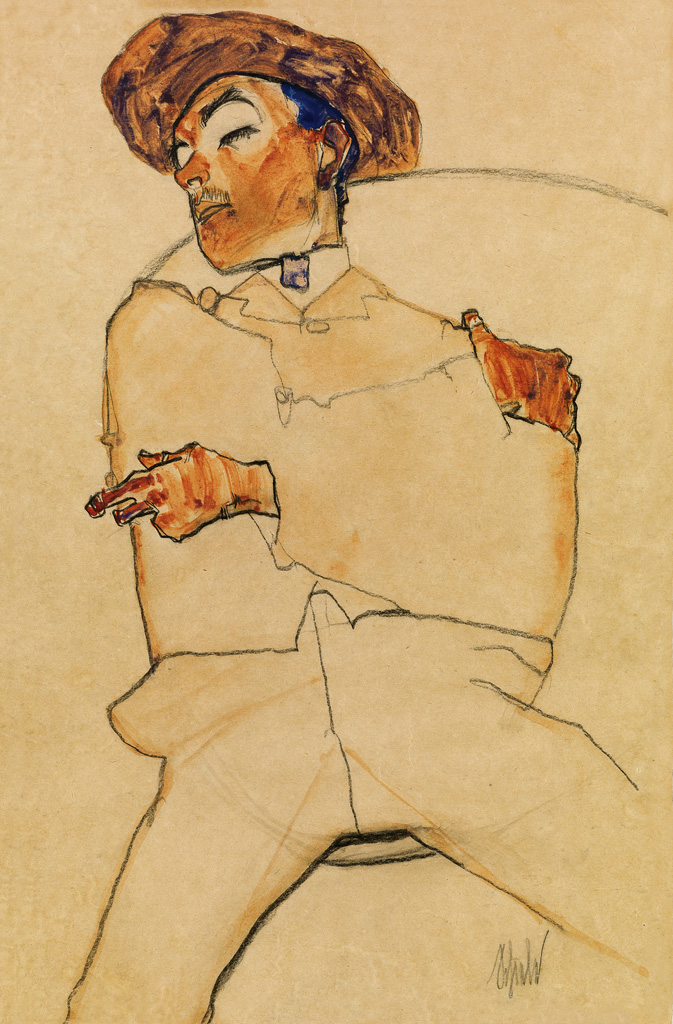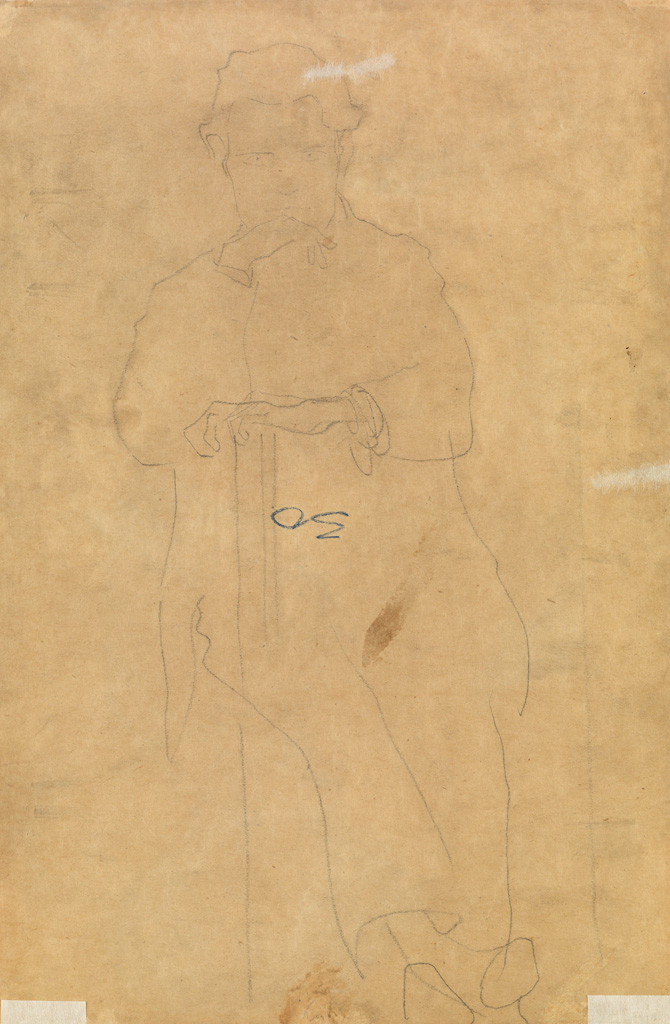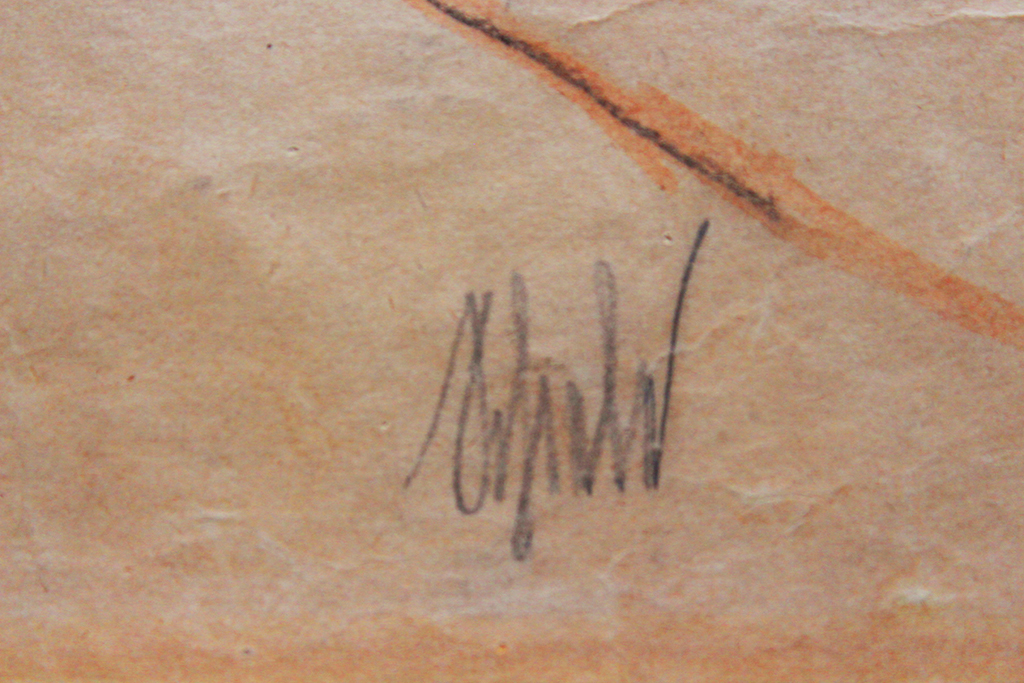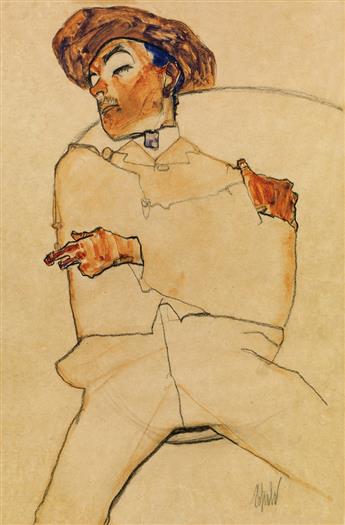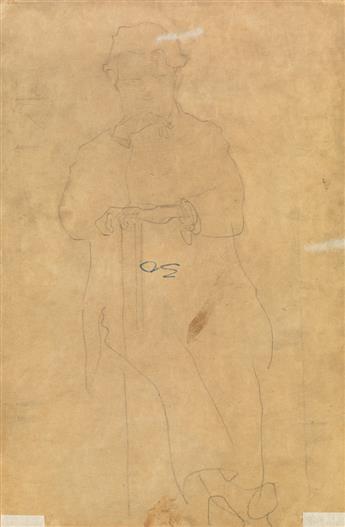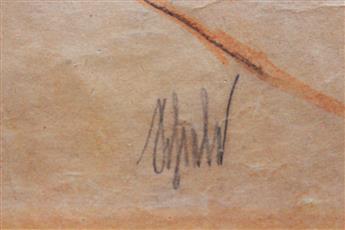Sale 2392 - Lot 423
Price Realized: $ 750,000
Price Realized: $ 905,000
?Final Price Realized includes Buyer’s Premium added to Hammer Price
Estimate: $ 200,000 - $ 300,000
EGON SCHIELE
Schlafender Mann.
Watercolor, pencil and black crayon, 1910. 448x296 mm; 17 5/8x11 5/8 inches. Signed in pencil, lower right recto. With a study of a man in pencil, verso.
Sold Kornfeld & Klipstein, June 19,1965, sale 116, lot 1045; Herbert Feist; Alice M. Kaplan; Galerie St. Etienne, New York; private collection.
Published in Kallir, Egon Schiele: The Complete Works , New York, 1990, page 417, D 617 (illustrated).
Exhibited "Egon Schiele: In Celebration of the 100th Anniversary of the Artist's Birth and the Publication of Egon Schiele: The Complete Works," November 13 1990-January 12, 1991, Galerie St. Etienne, New York, with the label on the frame back.
Schiele's (1890-1918) portraits represent some of the earliest Expressionist works in Austria. While his contemporaries worked mostly in either the Secessionist Wiener Werkstätte or academic styles, Schiele rejected the norm and instead chose to apply a raw and emotional physicality to his work through his use of color, line and gesture. This style was heavily influenced by Gustav Klimt, whom Schiele met in 1907 and took as his mentor. Klimt facilitated Schiele's entry into the 1909 Internationale Kunstschau and afforded him connections to various wealthy patrons. The same year, Schiele and other young Viennese artists formally rejected the academic tradition by establishing the Neukunstgruppe, or "New Artists Group," prompting his family to discontinue his financial support.
Much of the apparent anguish in Schiele's work stems from the resulting critical and social isolation in the early 1910s. His 1912 arrest and imprisonment for kidnapping and seducing a minor, charges which were subsequently dropped, and displaying pornographic art, for which he was convicted, sustained his view of himself as a martyr for his craft. In 1918, Schiele's promising career was tragically cut short when he succumbed to the Spanish flu epidemic at the young age of 28.
Fully realized watercolor studies by Schiele such as this are extremely scarce, as his career spanned only about a decade. Kallir notes that the subject of the present watercolor may be identified as either a self-portrait or a portrait of the artist Anton Peschka (1885-1940), who was a classmate of Schiele's at Vienna's Academy of Fine Art, a fellow member of the Neukunstgruppe and later Schiele's brother-in-law. Schiele explored self-portraiture repeatedly over the course of his short career through drawings, paintings and sculptures (see also lot 425).
This portrait is a stunning example of Schiele's experimentation with color and line, dating from a significant peak in his creative output in 1910, a year during which he gave particular focus to studies of the male form. The burnt reddish color of the sitter's flesh is characteristic of Schiele's work at the time, and the accenting blue hair and collar exemplify deliberately avant-garde choices. Though it is a clothed portrait, the angularity in Schlafender Mann parallels the emaciated figure-type common in Schiele's male nudes. The awkwardly crossed arms indicate a fitful sleep and imply Schiele's self-imposed mythology as a tortured artist, which he could have projected on Peschka as well, and the low perspective directs focus to the figure's suggestively open legs, imparting ideas of eroticism in Schiele's oeuvre.
This lot has been checked against the Art Loss Register's database (search S00105349) and confirmed with no matching records.
Schlafender Mann.
Watercolor, pencil and black crayon, 1910. 448x296 mm; 17 5/8x11 5/8 inches. Signed in pencil, lower right recto. With a study of a man in pencil, verso.
Sold Kornfeld & Klipstein, June 19,1965, sale 116, lot 1045; Herbert Feist; Alice M. Kaplan; Galerie St. Etienne, New York; private collection.
Published in Kallir, Egon Schiele: The Complete Works , New York, 1990, page 417, D 617 (illustrated).
Exhibited "Egon Schiele: In Celebration of the 100th Anniversary of the Artist's Birth and the Publication of Egon Schiele: The Complete Works," November 13 1990-January 12, 1991, Galerie St. Etienne, New York, with the label on the frame back.
Schiele's (1890-1918) portraits represent some of the earliest Expressionist works in Austria. While his contemporaries worked mostly in either the Secessionist Wiener Werkstätte or academic styles, Schiele rejected the norm and instead chose to apply a raw and emotional physicality to his work through his use of color, line and gesture. This style was heavily influenced by Gustav Klimt, whom Schiele met in 1907 and took as his mentor. Klimt facilitated Schiele's entry into the 1909 Internationale Kunstschau and afforded him connections to various wealthy patrons. The same year, Schiele and other young Viennese artists formally rejected the academic tradition by establishing the Neukunstgruppe, or "New Artists Group," prompting his family to discontinue his financial support.
Much of the apparent anguish in Schiele's work stems from the resulting critical and social isolation in the early 1910s. His 1912 arrest and imprisonment for kidnapping and seducing a minor, charges which were subsequently dropped, and displaying pornographic art, for which he was convicted, sustained his view of himself as a martyr for his craft. In 1918, Schiele's promising career was tragically cut short when he succumbed to the Spanish flu epidemic at the young age of 28.
Fully realized watercolor studies by Schiele such as this are extremely scarce, as his career spanned only about a decade. Kallir notes that the subject of the present watercolor may be identified as either a self-portrait or a portrait of the artist Anton Peschka (1885-1940), who was a classmate of Schiele's at Vienna's Academy of Fine Art, a fellow member of the Neukunstgruppe and later Schiele's brother-in-law. Schiele explored self-portraiture repeatedly over the course of his short career through drawings, paintings and sculptures (see also lot 425).
This portrait is a stunning example of Schiele's experimentation with color and line, dating from a significant peak in his creative output in 1910, a year during which he gave particular focus to studies of the male form. The burnt reddish color of the sitter's flesh is characteristic of Schiele's work at the time, and the accenting blue hair and collar exemplify deliberately avant-garde choices. Though it is a clothed portrait, the angularity in Schlafender Mann parallels the emaciated figure-type common in Schiele's male nudes. The awkwardly crossed arms indicate a fitful sleep and imply Schiele's self-imposed mythology as a tortured artist, which he could have projected on Peschka as well, and the low perspective directs focus to the figure's suggestively open legs, imparting ideas of eroticism in Schiele's oeuvre.
This lot has been checked against the Art Loss Register's database (search S00105349) and confirmed with no matching records.
Exhibition Hours
Exhibition Hours
Aliquam vulputate ornare congue. Vestibulum maximus, libero in placerat faucibus, risus nisl molestie massa, ut maximus metus lectus vel lorem.


